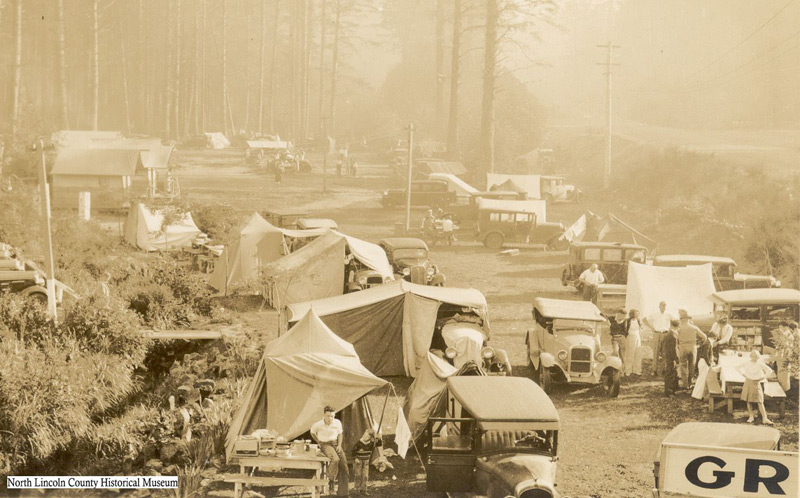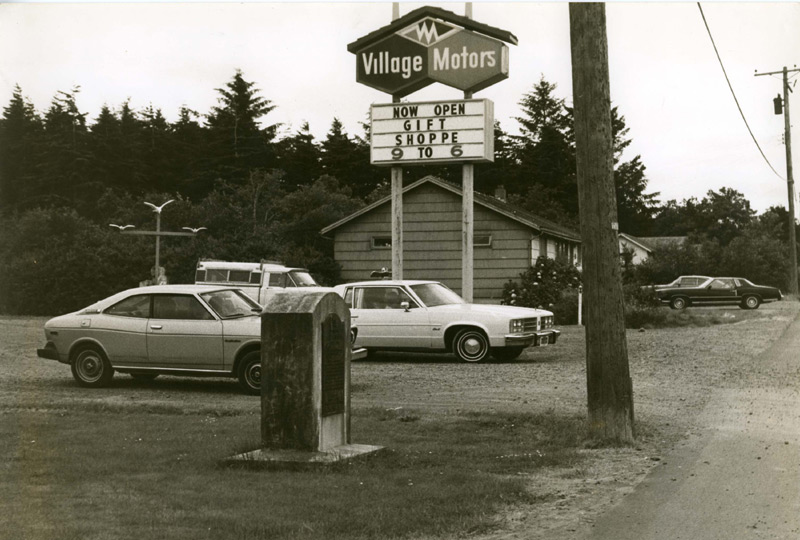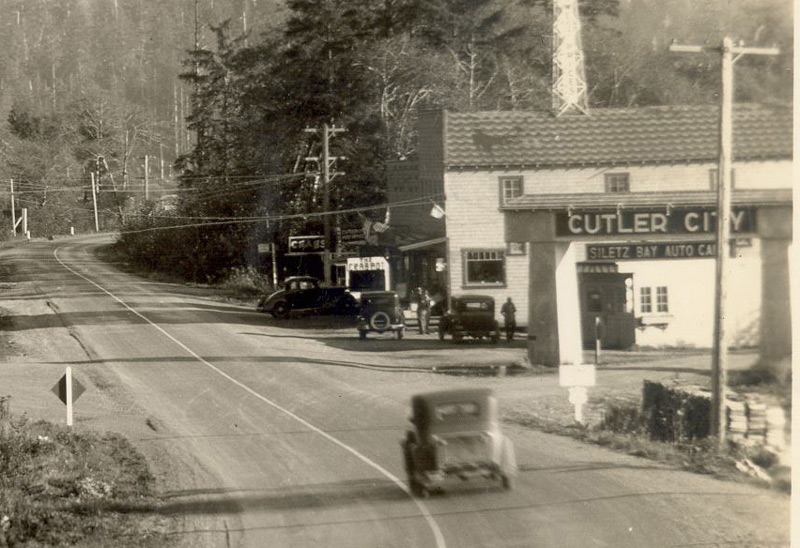Auto Camps to Motor Lodges and Motels on Oregon Coast | History Part 2
Published 02/20/21 at 6:26 AM PDT
By Oregon Coast Beach Connection staff

(Oregon Coast) – When tourism first kicked into life on this coastline, it was a rough experience of primitive camping. No glitzy comforts for even this time period. No room with a view. For almost everyone, it was simple tents that you could rent: hotel rooms were rare for about the first forty years and then only for the upper class. (Above: the Greenville Auto Camp in North Bend, 1949; courtesy Coos History Museum)
That encapsulates part one of this series on the rugged first three decades of Oregon coast tourism: the evolution of staying overnight on the beach from about 1880 through 1920. Part two picks up in the 1910s, when small cottages were beginning their rise on plots of land sold to the vacationing middle class. More hotels had been built along with some inns and multi-roomed lodges, and as the 1920s rolled around, something new came with the better roads being built.
Includes exclusive listings; some specials in winter
In Cannon Beach:
Includes rentals not listed anywhere else
In Manzanita, Wheeler, Rockaway Beach:
Some specials for winter
In Pacific City, Oceanside:
Some specials for winter
In Lincoln City:
Some specials for winter
In Depoe Bay, Gleneden Beach:
Some specials for winter
In Newport:
Look for some specials
In Waldport
Some specials for winter
In Yachats, Florence
Some specials for winter
Southern Oregon Coast Hotels / Lodgings
Reedsport to Brookings, places to stay; winter deals
It was called the auto camp. These were a brief but intriguing middle step between tent cities near the sands and actual motels. These evolved quickly and had some different forms.
One was where tents were still present – either by attaching it to your vehicle or as a separate structure. The other kind was a platform where a tent was on top. Other types had a small but sturdier structure on the platform, sometimes called a cabin, which either had a roof or a tent-style top.
According to Jeff Syrop of the North Lincoln County History Museum in Lincoln City, these grew out of a quick increase in demand, especially as Highway 101 began construction through the mid decade.

Nelscott Auto Camp, 1920s, courtesy North Lincoln County History Museum
“Auto camps were a response to a rapid increase in visitors,” Syrop said. “They were a fast and easy way to have many visitors. I think that cabins, lodges, motels and such were in the works, but auto camps came first out of ease and to handle immediate high demand.”

Agate Beach Inn, circa 1910
Meanwhile, more inns and hotels were also being built along the Oregon coast. By the roaring ‘20s there was the Gilmore Hotel in the little village of Nye Beach, which was just about to be fused with Newport. Eventually, that became the innovative Sylvia Beach Hotel.
A newspaper ad from Newport in 1927 touts the Gilmore as well as a tent city, where you could still rent a tent for the night or a cottage. It also showcases the Agate Beach Inn, a small hotel-like business that was gone by mid century.
In the Cannon Beach area, about six or seven auto camps were present in the ‘20s and ‘30s. In the Coos Bay area there were numerous ones as well, showcased here with these photos provided by the Coos History Museum.
Then, near the close of the decade, Highway 101 was finished through much of the Oregon coast.
“In 1928, when the highways that connected us to the rest of Oregon were complete, auto camps began popping up and continued through the 50s,” Syrop said.
At that time there was no Lincoln City, just a smattering different villages close to each other that would become one in the early ‘60s. In the ‘20s, there were quite a few auto parks in this area, Syrop said, often named after their villages: Nelscott Auto Park, Taft Auto Park and the Cutler City Auto Park, among others.
Syrop said the ‘30s brought yet another stage in Oregon coast lodging: auto parks were now building little cabin structures instead of tents. These really became evident on the south coast by this time, according to the Coos History Museum.

Photo courtesy Coos History Museum
At North Bend’s Sherman Avenue, there was one at the end of the street, said the museum’s Steven Greif. You can see the sign far back: that is now Simpson Park. “The photo was taken prior to 1933 when construction began on the McCullough Bridge,” he said.
Another auto camp of some fame was the Greenville Auto Camp, pictured at the top in 1949. It came complete with its own gas station.
The Greenville photo speaks volumes about what happened next in the evolution of Oregon coast lodgings: the motor lodge. That is a charming bit of Americana now mostly gone, but you can see how the concept was firming up at the Greenville. Little garages for your vehicles gave way to small, comfortable rooms. It was the precursor to the motel. Most had gravel areas where you parked your car in front of your unit, which was now part of a larger building instead of a single cabin. Hence the term motel.

Agate Beach Motor Lodge, now the Agate Beach Motel
In the ‘40s the now famous Agate Beach Motel in Newport sprang up, originally a motor lodge. In the ‘20s, a series of small cottages were built around a small beachside lake that no longer exists, in a village that later became part of Lincoln City. Those were soon fused into a motor lodge, eventually becoming Lincoln City’s Whistling Winds Motel. In Cannon Beach, the Blue Gull Inn was another from the ‘40s, which is now part of Inn at Haystack Rock.
While auto camps trailed off as well as motor lodges, somewhere in the post-war years the term motel was invented, and those now-coveted bits of Americana were replaced by hotels and motels all over. No one’s missing the rickety cabins or tent cities, but the historic charm of the old-style motor lodges can still be found in their descendants, the motel. See part one. MORE HISTORICAL PHOTOS BELOW
Oregon Coast Hotels in this area - Where to eat - Maps - Virtual Tours - See South Coast Hotels
Cannon Beach Lodging
Nehalem Bay Lodgings
Manzanita Hotels, Lodging
Three Capes Lodging
Pacific City Hotels, Lodging
Lincoln City Lodging
Depoe Bay Lodging
Newport Lodging
Waldport Lodging
Yachats Lodging
Oregon Coast Vacation Rentals
Oregon Coast Lodging Specials

Another Coos Bay auto camp in the early '60s, courtesy Coos History Museum

Cutler City's Siletz Auto Camp, courtesy North Lincoln County History Museum
More About Oregon Coast hotels, lodging.....
More About Oregon Coast Restaurants, Dining.....
LATEST Related Oregon Coast Articles
History and histrionics: one outstanding yet funky little motel on the outer edges. Newport hotel reviews, lodging news, Newport lodging
Where Beaches and Village Streets Practically Scream Oregon Coast History
Walking here automatically means you're walking on history. Newport, Nye Beach
Lincoln City's Coho Oceanfront Lodge Continues Pushing Boundaries on Oregon C...
Plenty of perks - a kind of upscale without all of that price tag. Lincoln City lodging, hotel reviews, Gleneden Beach
Quirky to Obscure Rumors and History of N. Oregon Coast's Cape Meares Lighthouse
Name mix-ups, Meares' boo boo's, becoming automated. Oceanside, Pacific City, history
Back to Oregon Coast
Contact Advertise on BeachConnection.net
All Content, unless otherwise attributed, copyright BeachConnection.net Unauthorized use or publication is not permitted



















































